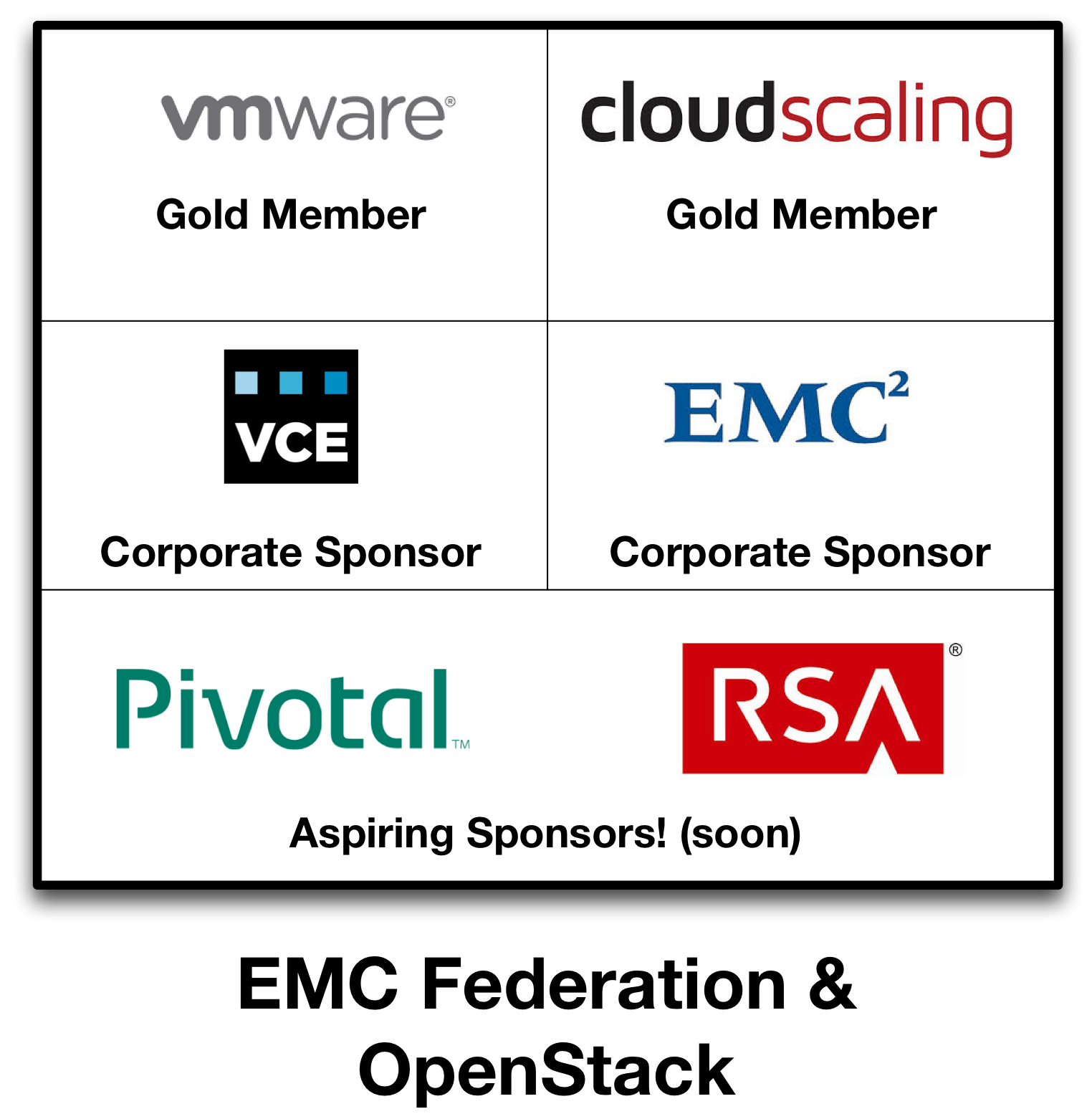The EMC Federation Joins the OpenStack Foundation
Last week a major set of milestones was reached for the EMC Federation’s involvement with OpenStack. First, EMC and it’s affiliated companies and brands (VMware, VCE, Pivotal, RSA, Cloudscaling) determined a cohesive strategy for engagement with the OpenStack Foundation Board. Second, EMC appointed a VMware employee, Sean Roberts (@sarob), as the official representative of EMC and hence the EMC Federation generally. This means that I am no longer the EMC (Cloudscaling) OpenStack Foundation Gold Director.
The why of this may be confusing so I will briefly explain the background and then provide some more details on what exactly transpired.
Background
By and large the OpenStack bylaws have stood the test of time quite well at this point. Most of the upcoming proposed changes are simply things we could only have known in hindsight. One area that I think the bylaws got right are the articles that limit participation by “Affiliated” companies:
2.5 Affiliation Limits. Gold Members and Platinum Members may not belong to an Affiliated Group. An Affiliated Group means that for Members that are business entities, one entity is “Controlled” by the other entity. “Controlled” or “Control” means one entity owns, directly or indirectly, more than 50% of the voting securities of the Controlled entity which vote for the election of the board of directors or other managing body of an entity, or which is under common control with the Controlled entity. An Affiliated Group does not apply to government agencies, academic institutions or individuals.
What this means, in essence, is that if there are two companies with a relationship like parent/child or joint venture, in which one owns more than 50% of the other, only ONE of the companies can join the OpenStack Foundation as a Gold or Platinum Member. This is a good measure to prevent a group of companies from “stacking the deck” within the OpenStack Foundation and using that as leverage to control or dominate OpenStack, which is something no one wants. I also need to note that any company may also have one to two Individual Members represent them. Two Directors from any single affiliated group is the maximum representation on the OpenStack Board of Directors. This works out to one Gold or Platinum Director plus one Individual Director OR two Individual Directors. This is why I am allowed to run as an Individual Director in 2015. Of course, I would very much appreciate your support in this endeavour!
So, things became very interesting upon EMC’s acquisition of Cloudscaling as it inherited the Gold Member status of Cloudscaling while VMware also retained their Gold Member status, creating an edge case where the Bylaws were technically in violation. This required EMC and VMware to work closely with the Foundation staff to resolve the situation.
This is why VMware resigned their Gold Member status and why EMC appointed a VMware employee as a representative for EMC and hence the EMC Federation.
Which means we should quickly explain what the EMC Federation is.
EMC Federation
The EMC Federation is composed of a number of different entities, from security companies, to storage, to Platform-as-a-Service, big data, virtualization, converged infrastructure, and now OpenStack via the Cloudscaling acquisition. Members of the EMC Federation are already representatives on the OpenStack Foundation Board of Directors, OpenStack Foundation Gold Members, OpenStack Foundation Corporate Sponsors, and have deepening ties to OpenStack generally.
In April of 2013, EMC and VMware launched Pivotal and created a federation of its businesses. EMC is the majority owner, by a large margin of VMware, Pivotal, and RSA is a wholly owned subsidiary. Recently, VCE, the leader in converged infrastructure joined the Federation. Federation messaging and joint solutions were prominent during EMC World 2014. The following diagram gives you some idea of how the Federation is organized.
When asked about why the Federation model is needed and what differentiates the companies from competitors, the answer is “choice”. While VMware is the leading hypervisor, EMC also desires the opportunity to forge alliances and solutions with Microsoft, Citrix, and others. Conversely, VMware desires to support and work with a variety of storage and security solutions.
Similarly, members of the Federation desire to operate and support OpenStack’s mission in different manners (converged infrastructure, appliance models, and software distributions) while also supporting the joint goals of empowering and promoting OpenStack within the enterprise.
Wikibon covers the EMC Federation Model extensively here:
http://wikibon.org/wiki/v/Primer_on_the_EMC_Federation
The EMC Federation OpenStack Strategy
As a group, the EMC Federation strongly desires to play by the rules of the OpenStack community, while deepening our commitments and contributions. As a group we are already a #6 contributor to the latest release and we aspire to go even further. OpenStack is a critical strategy for the Federation as a whole, even for members like Pivotal who see a significant increase in the number of enterprises who wish to run CloudFoundry on top of OpenStack.
What this meant for us when resolving the Bylaws issue is that we wanted to have the entire EMC group represented as a whole, such that others like VMware, VCE, and Pivotal, could all be a part of the picture. The Bylaws however require that the Gold Member selected is an actual legal entity.
Our final resolution was then to have VMware resign their Gold Membership, EMC retains the Cloudscaling Gold Membership, and in order to show EMC Federation coordination, EMC is appointing Sean Roberts to represent EMC, and hence the entire Federation, as our Gold Member representative. Finally, all of the branding on the OpenStack Foundation website will be a Federation-oriented branding (EMC2).
Meanwhile, behind the scenes, I’m working closely with Sean Roberts of VMware, Josh McKenty of Pivotal, Jay Cuthrell of VCE, and others to make sure that we have cohesion across the Federation.
Hopefully this helps explain these recent changes.
